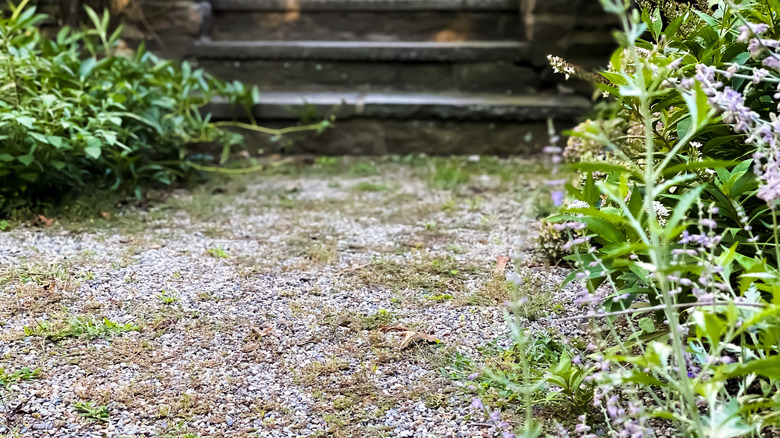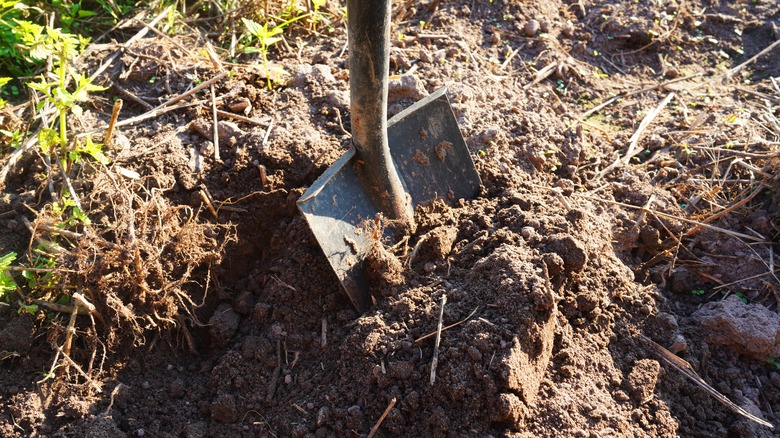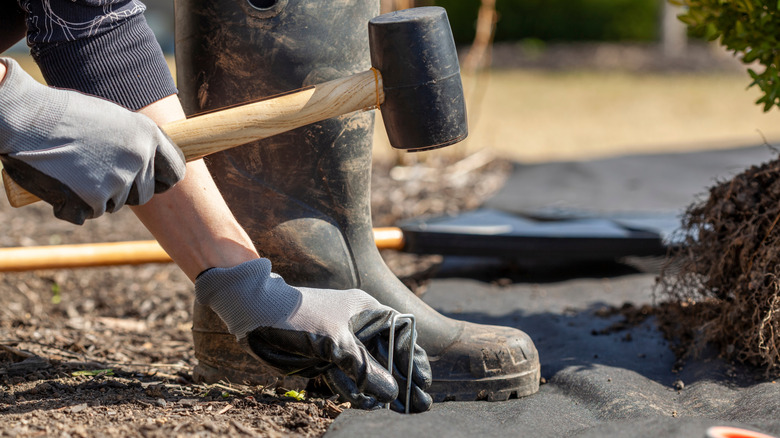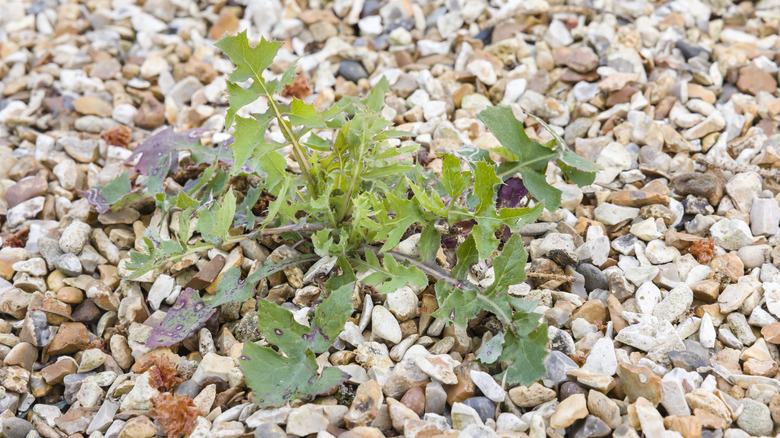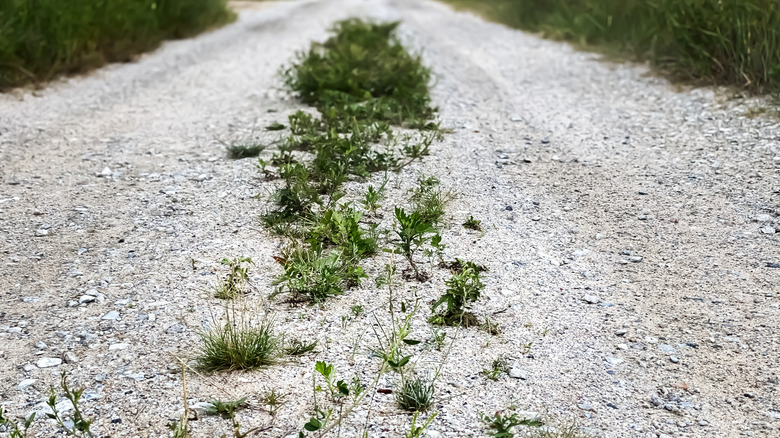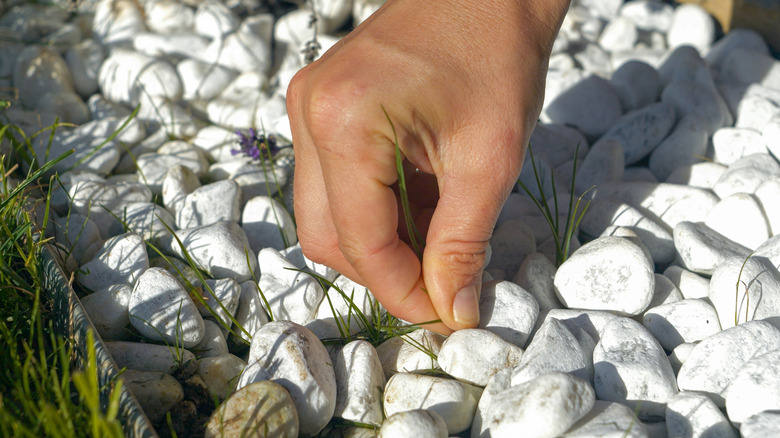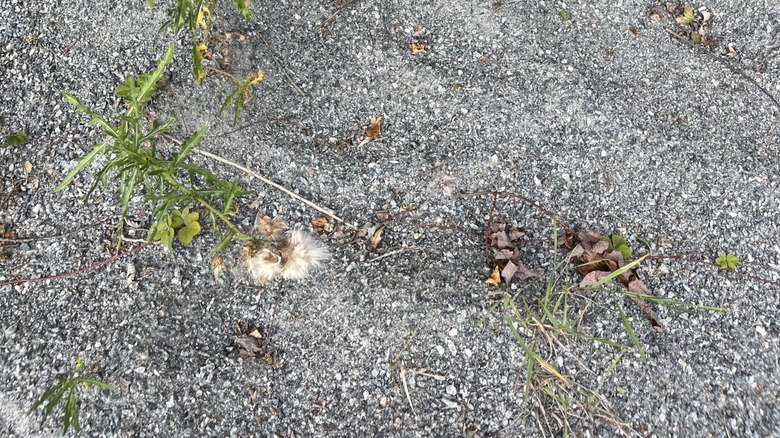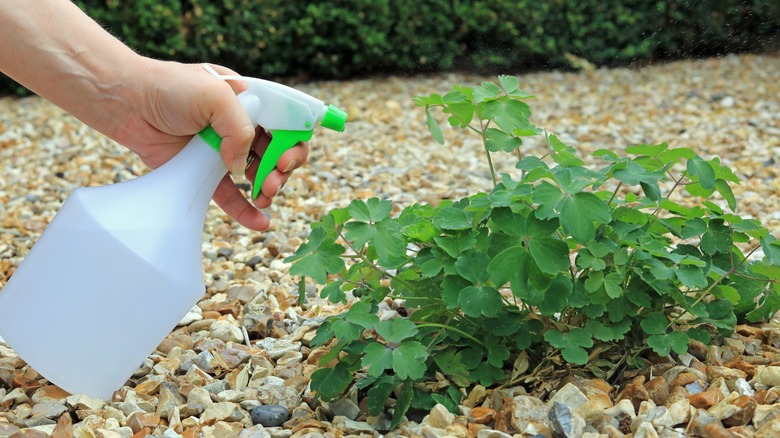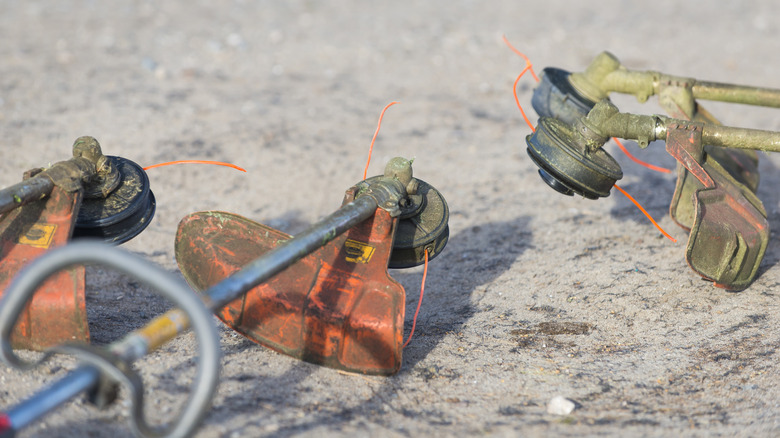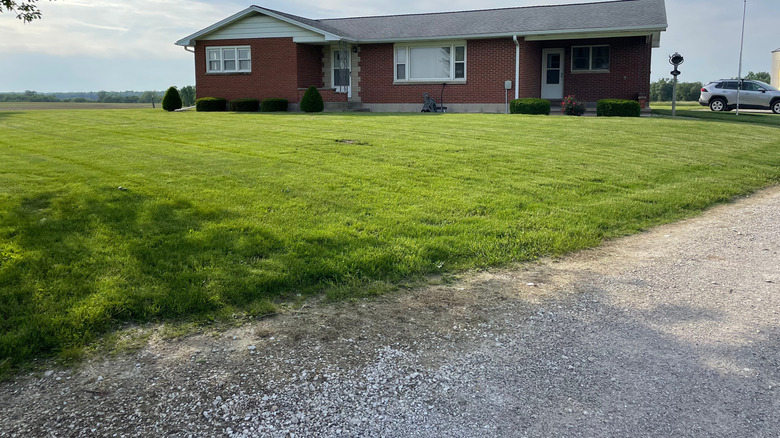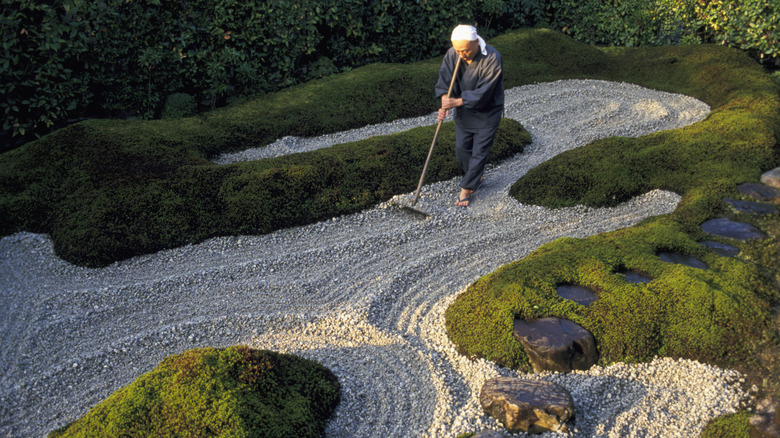Mistakes Everyone Makes When Dealing With Weeds Growing In Gravel
We may receive a commission on purchases made from links.
Preventing weeds from taking over your lawn and garden is already a difficult task, so it's especially frustrating to see them sprouting in your gravel driveway or walkway. You may have thought the small rocks would act like a weed suppressor, but lo and behold, thorny plants are poking through.
You're not alone in struggling with this predicament, but there are several mistakes that plague many people's efforts to prevent or kill the weeds, causing them to return again and again. If you're looking for more effective solutions, continue reading. You may discover a mistake or two you've been making and learn what to do instead.
Forgetting to thoroughly weed the area before laying gravel
Many people skip a very important step when laying their gravel driveway. Before any gravel is poured or spread, you should thoroughly weed the area. Failing to do so may leave several weeds just beneath the surface that could soon sprout through the gravel pieces, leading to nothing but headache and frustration. Conversely, if you take the time to carefully weed the area, you'll be able to eliminate many opportunities for these nuisances to reach the surface.
If you haven't already laid your gravel driveway, this should be an easy step to execute. If you have already poured the gravel, removing it temporarily may be well worth the time and effort to help you clear up the weed problem you're dealing with. Shovel the gravel to one side or another alternate location, then pull any and all weeds you see. Be sure to turn the soil and look for any other weeds or weed parts that may be hidden beneath the surface. You'll find much greater success pulling the entire weed out without the gravel in your way. Once you've weeded and the gravel is returned, your problem should be significantly decreased.
Failing to place landscaping fabric beneath the gravel
There is another common mistake that many people make when installing a gravel walkway or driveway that may lead to increased weed problems for years to come. Before you even lay any gravel — after you've thoroughly weeded the area — you should put down a layer of landscaping fabric. Landscaping fabric is designed to keep weeds from germinating. And, while it isn't foolproof, especially after a few years of use, anything that will limit the number of weeds that break through the gravel can be helpful. It is important to note that there are some downsides of landscaping fabric, including its potential to negatively impact the soil health and limit the amount of water that is able to get to wanted plants in the area. However, since you are trying to keep weeds from growing through gravel, not in a flower bed, this is probably less of a concern.
If you've already laid your gravel, you can use a shovel to move it and lay some landscaping fabric over the entire area. Once the landscaping fabric is in place, you can return the gravel back to the area, placing it over the fabric. There are also a few alternatives to landscaping fabric that you could consider, including cardboard, newspaper, and plastic sheeting. These work in a similar fashion, stopping the weeds from growing up through the gravel.
Skipping the use of a pre-emergent herbicide
If weeds have already started popping up on your driveway, and you're only just now starting to think about what you should do, then you've already made a mistake. Instead of waiting until the weeds begin appearing, it is important to be proactive. One of the best things you can do is to apply a pre-emergent herbicide early in the season before the weeds start growing. As the name suggests, pre-emergents are designed to stop weeds before they emerge; these herbicides will not work to kill weeds that are already growing.
The best time to apply a pre-emergent will vary based on the type of weed you're targeting and when it starts growing. However, these products can remain active in the soil for several months (the specific time varies between products), so you can apply them in the early spring before temperatures warm up too much. Read the packaging and do some research about the types of weeds you're dealing with to determine whether a second — or third — application later in the year will be necessary.
If you have already made the mistake of skipping a pre-emergent, applying one now won't help with the weeds that have already sprouted. However, you could still use the herbicide to stop new weeds that haven't emerged yet. Just remember, most of these herbicides will need to be applied with at least half an inch of water in order to push it deep enough into the soil where it'll be able to attach the root systems of new weeds, so be sure to have a hose on hand.
Letting the weeds grow instead of addressing the problem promptly
We've all heard the saying, "Don't put off until tomorrow what you can do today." When it comes to dealing with weeds growing in gravel, this is sound advice to follow. Failing to act promptly can magnify the problem that you're facing. Weeds that are left to grow will not only get taller and become more noticeable around the gravel. They'll also develop deeper and stronger roots and overtake more of the driveway. Once this happens, the prospect of removing them will be much more challenging.
Instead of procrastinating, once you notice the first signs of weeds appearing among the gravel rocks, it is time to jump into action. Smaller weeds will be easier to pull by hand, as they didn't have the opportunity to spread and cover larger portions of the gravel. Your future self will thank you for all the extra work and frustration you avoided.
Pulling out only the top of the weeds
Pulling weeds out by hand can be an effective and chemical-free solution for getting them out of your gravel. However, you'll want to avoid the common mistake that many people make of simply removing the part of the weed that they can see. Only cutting off the top of the weed isn't enough to kill it. If you leave the root (or even just a portion of the root behind), the weed is only going to sprout right back up.
Instead, when removing weeds from gravel, you must take care to extract the entire root system of each weed you pull. The correct weed-pulling technique can make all the difference. Grab the base of the weed, as far down as you can reach, and pull it out carefully. Rock the weed back and forth as you pull to help loosen the roots and avoid snapping off the top. If the top of the weed does break off as you're pulling, use a weed removal tool, such as the Fiskars Ergo Weeder Tool, to dig out the full root. Another tip is to work when the ground is moist. If the soil is wet from a recent rainstorm, the roots will be easier to pull out.
Digging too deep when removing weeds
Now that you know to avoid the mistake of leaving some or all of the roots behind, you might decide to avoid this problem by digging very deep when pulling out a weed. Unfortunately, this too would be a mistake. While you do want to remove all of the root system, digging too deep into the soil can introduce a new problem. Weed seeds are lurking beneath the surface, so if you dig too deep, you risk bringing these seeds closer to the surface. When this happens, all they'll need is a bit of water and — boom! — you'll be facing a new weed problem right after you thought you cleared up the last one.
To avoid turning the soil too much and bringing up these new weed seeds, take care not to dig more than about 2 inches beneath the surface. This is another reason why it is important to tackle a weed problem as soon as you notice it. Newer weeds will have shorter and weaker roots, making it easier to remove them without having to dig too far down.
Use herbicides when the gravel is close to garden beds
If you're trying to clear up a weed problem on your gravel driveway or walkway, post-emergent herbicides are one potential solution to explore. If things have gotten out of hand and the weeds have spread or grown considerably, these herbicides can help you reign things back in. However, you don't want to fall victim to the mistake of using herbicides if your gravel walkway or driveway is in close proximity to a garden with wanted plants.
Most herbicides are non-selective, meaning they kill any plants they come into contact with. So, if they touch your wanted flowers and other garden plants, they will kill them as well. Even if you exercise extreme caution when spraying and avoid purposefully letting the herbicide come into contact with them, it may not be enough. Herbicides may "drift" from the area where you spray them to nearby plants. Certain active ingredients found in many herbicides, including triclopyr, 2,4-D, and dicamba, may vaporize and travel through the air, landing on other plants in the garden. Similarly, even homemade weed killers like a DIY salt and vinegar herbicide, will also kill other plants they come into contact with.
If you decide to still go the herbicide route, then you should be purposeful not only about where you apply it, but when you do so. Drift is more likely to occur when it is windy or very hot and dry. So, choose a day when there is some moisture in the air, the ground is damp, and there's nothing more than a slight breeze before spraying the weeds in the gravel.
Trying to remove weeds from the gravel using a string trimmer
String trimmers are often recommended for controlling weeds. After all, these tools are often referred to as weed wackers. However, while they can be an effective tool for keeping weeds from overtaking your lawn, don't make the mistake of using one to clear away these unwanted nuisances from a gravel driveway or walkway. Gravel — and other rocky surfaces — can damage a string trimmer. The wires on these trimmers are not designed for use with such hard surfaces and will end up breaking down or becoming damaged more quickly.
Beyond the potential damage to the tool, using a string trimmer on gravel also creates a safety hazard. The wires move quickly to cut through weeds and grass. However, if they bump into the gravel when moving so quickly, they're likely to send the little pieces of rock flying into the air. Once airborne, the gravel may cause an injury by hitting your body. So, when you need to remove weeds from gravel, put that string trimmer aside and save it to use on the lawn. Opt for hand pulling, careful use of an herbicide (if it makes sense for your landscape), or another approved method instead.
Overlooking the benefits of edging the driveway
If you didn't edge your gravel driveway or walkway when laying it, then you've just identified one mistake you'll probably want to correct. Adding edging around gravel helps keep the area better separated from any grass growing on either side of it. This separation works to keep weeds in the grass from moving over to the driveway. Edging a gravel walkway or driveway can deliver additional benefits too. It can help minimize erosion and work to keep the gravel from getting pushed onto the lawn. Moreover, an edged driveway just offers better aesthetics and enhances your home's curb appeal.
If you didn't edge your gravel driveway or walkway, all is not lost. There is no time like the present to choose one of the best materials for edging a gravel driveway and put it to good use. Some natural materials to consider include bricks, pavers, river rocks, wood, and stones. Alternatively, you can also use man-made materials to help contain the gravel and achieve a more manicured look. Some of these options include aluminum strips, rubber strips, or recycled plastic strips (called bender boards). If you opt for a natural material — particularly river rocks — don't forget to add a layer of landscaping fabric beneath them. Without this barrier, porous materials may serve as a host for even more weeds.
Not laying enough gravel
If you only lay a very thin layer of gravel on your driveway or walkway, you're giving weeds a better chance of poking through the rocks and reaching the surface. A 2- or 3-inch layer of gravel simply won't be enough to stop weeds. You might end up feeling like you're constantly playing Whack-a-Mole; as soon as you get rid of one weed, another one will appear in a new location.
To avoid this frustration, add more gravel to your driveway. Aim to give it a depth of at least 6 inches to make weeds have to really fight to see the light of day. With this many rocks over the soil, less water will be able to reach them to create the favorable conditions they need to sprout. A thicker layer of gravel can offer additional benefits, particularly if you want to park an RV or a heavier work vehicle on your driveway.
Forgetting to regularly rake the gravel
Raking a gravel driveway regularly is an important maintenance task for several reasons, including helping you control weeds. Moving the gravel around will disturb any weeds that may be starting to sprout. It can help you cut off their growth before they become large and start taking over the space. Raking also helps to keep the gravel evenly spread out over the driveway. Wind and rain can cause it to shift, leaving some areas thicker, while others may have bare spots. By spreading the gravel back out as it should be, the driveway will not only look nice, but also maintain that consistent 6-inch depth you're going for.
To even out the gravel and disrupt any lurking weeds, you'll want to use a gravel rake, such as the Walensee Heavy Duty Garden Rake. Rake over the entire surface of the driveway, and shift any gravel that is out of place. Working with a hoe, like the Corona Extended Reach Hoe and Cultivator, in addition to the rake, can make your efforts to get rid of weeds more effective.
Not knowing when to turn to a professional for help
Following the recommendations above and avoiding common mistakes will often be sufficient to help you deal with weeds in gravel. However, despite your best efforts, you may still find that there are too many weeds popping up and taking over your gravel driveway. Some may simply not have the available time to dedicate to maintaining their driveway, or may not feel like they are able to handle some of the more involved tasks (such as moving the gravel to lay a landscaping fabric).
In these cases, you are probably best hiring a professional to help you with your weed problems. Professional landscapers know the most effective tips and tricks to kill weeds and prevent them from coming back. They are also experienced and should have all the necessary tools to help them complete the job for you. Whether you want to hire someone to continuously maintain your gravel driveway (and the surrounding landscaping) or are just looking for some help resetting everything to keep the workload down in the future, a professional should be able to deliver.
